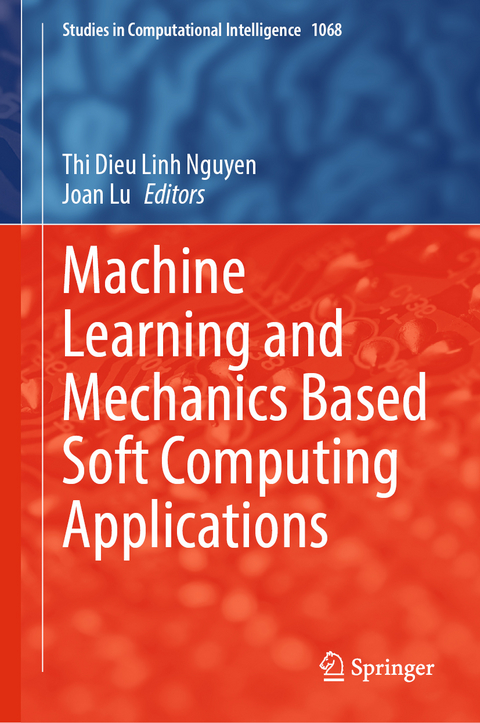
Machine Learning and Mechanics Based Soft Computing Applications
Springer Verlag, Singapore
978-981-19-6449-7 (ISBN)
This book highlights recent advances in the area of machine learning and robotics-based soft computing applications. The book covers various artificial intelligence, machine learning, and mechanics, a mix of mechanical computational engineering work. The current computing era has a huge market/potential for machine learning, robotics, and soft computing techniques and their applications. With this in view, the book shares latest research and cutting-edge applications useful for professionals and researchers in these areas.
Dr. Thi Dieu Linh Nguyen is Deputy Head of Science and Technology Department, Hanoi University of Industry, Vietnam (HaUI). She has more than 20 years of academic experience in electronics, IoT, smart garden, and telecommunication. She received Ph.D. in Information and Communication Engineering from Harbin Institute of Technology, Harbin, China, in 2013; she has authored or co-authored many research articles that are published in journals, books, and conference proceedings. She is editor for many books and also a board member for the International Journal of Hyperconnectivity and the Internet of Things (IJHIoT) IGI Global, USA; Information Technology Journal; Mobile Networks and Application Journal and some other reputed journals and international conferences. She has attended many conferences as keynote speaker, conference chair, guest honor; and chaired many technical events in different universities in Vietnam. She can be contacted at nguyen.linh@haui.edu.vn / nguyenlinh79.haui@gmail.com Joan Lu is in the Department of Computer Science and is the research group leader of Information and System Engineering (ISE) in the Center of High Intelligent Computing (CHIC), having previously been a team leader in the IT department of Charlesworth Group publishing company. Professor Lu has published seven academic books and more than 200 peer-reviewed academic papers.
Chapter 1 - LS-TFP: A LSTM-Based Traffic Flow Prediction Method in Intelligent Internet of Things.- Chapter 2 - Threshold Text Classification with Kullback-Leibler Divergence Approach.- Chapter 3 - Cellular Automata-based Simulation Model for Water Quality Management of Pangasius Ponds.- Chapter 4 - Deep-IDS: A lightweight Neural Network based Intrusion Detection System.- Chapter 5 - Heuristic methods solving Markowitz Mean-Variance portfolio optimization problem.- Chapter 6 - Context-based and Collaboration-based Product Recommendation Approaches for a Clothes Online Sale System.- Chapter 7 - Recommendation Approaches for a Clothes Online Sale System.- Chapter 8 - A cost-effective control system of the biogas based electrical generator.- Chapter 9 - Parallel, Distributed Model-checking of Composite Web-services with Integrated Choreography and Orchestration.- Chapter 10 - An application of logistic regression model in the student’s academic performance at HUST, Vietnam.- Chapter 11 -Soft Robotics Fingered-Hand Based on Working Principle of Asymmetric Soft Actuator.- Chapter 12 - Control design for 400Hz Ground Power Unit.- Chapter 13 - Rapid design of square-spiral metamaterial for Enhanced Wireless power transfer applications using Artificial Neural Networks.- Chapter 14 - GIS and RS application for Land use status quo mapping in 2020 and Land use change assessing in Thu Dau Mot city.- Chapter 15 - Particle Swarm Optimization for Acceleration Tracking Control of an Actuator System.- Chapter 16 - Count the Number of Steel Bars based on Deep Learning.- Chapter 17 - Hybrid SARIMA - GRU model based on STL for forecasting water level in Red river North Vietnam.- Chapter 18 - Activity Based Learning: An Analysis to Teach Learners Using Online Methodologies.- Chapter 19 - Use of a Fatigue Framework to Adopt a New Normalization Strategy for Deep Learning Based Augmentation.- Chapter 20 - An Innovative and Smart Agriculture Platform for Improving the Coffee Value Chain and Supply Chain.- Chapter 21 - Complex Shear Imaging Based on Signal Processing and Machine Learning Algorithms.- Chapter 22 - Breast Cancer Detection Based on UWB Dataset And Machine Learning.- Chapter 23 - A review of mathematical methods for flexible robot dynamics modeling and simulation.- Chapter 24 - Digital Twins of Robotic Systems: Increasing capability for industrial applications.- Chapter 25 - Optimal Motion for Humanoid Robotic Arms using Kinect Camera.- Chapter 26 - 6G Wireless Communication Systems and Its Applications.- Chapter 27 - Compensation Techniques for Non-linear effects using NG-RoF-DSP: A Review.- Chapter 28 - An IoT solution designed for remote automatic control and supervisor systems to key environmental factors and diseases in coffee farms in Vietnam.- Chapter 29 - Artificial Intelligence As a Strategic partner to HRM 4.0.
| Erscheinungsdatum | 23.03.2023 |
|---|---|
| Reihe/Serie | Studies in Computational Intelligence ; 1068 |
| Zusatzinfo | 165 Illustrations, color; 26 Illustrations, black and white; IX, 327 p. 191 illus., 165 illus. in color. |
| Verlagsort | Singapore |
| Sprache | englisch |
| Maße | 155 x 235 mm |
| Themenwelt | Informatik ► Theorie / Studium ► Künstliche Intelligenz / Robotik |
| Technik | |
| Schlagworte | Artificial Intelligence • Biogeography-based optimization • Deep Learning Methods • Free Search Algorithm • Fuzzy Modeling • Markowitz Mean-Variance • Mobile Robot • Optimum modulus methods • Particle swarm optimization • Robotics and Applications |
| ISBN-10 | 981-19-6449-1 / 9811964491 |
| ISBN-13 | 978-981-19-6449-7 / 9789811964497 |
| Zustand | Neuware |
| Haben Sie eine Frage zum Produkt? |
aus dem Bereich


